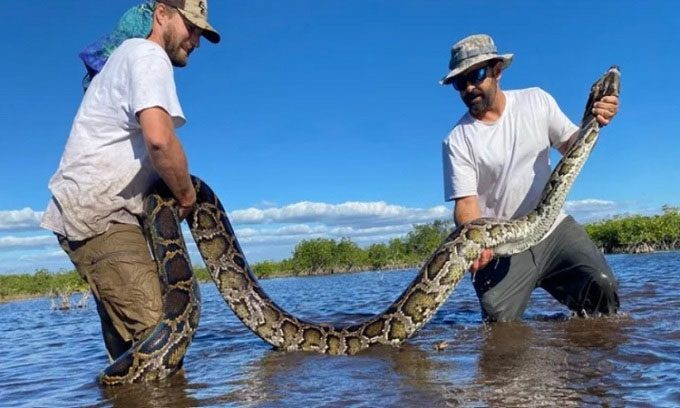The Everglades National Park has made significant efforts to control and eliminate Burmese pythons. However, completely eradicating this species is nearly impossible due to their large numbers and the difficulty in capturing and killing them.

Biologists capture a female python in southwest Florida after tracking a male python. (Photo: Conservancy of Southwest Florida).
The U.S. Geological Survey (USGS) reported that Burmese pythons in South Florida present one of the most challenging management issues related to invasive species, according to a report by Fox News on March 20. Although this species of python was first discovered in the Everglades in 1979, it wasn’t until the late 1990s to early 2000s that state authorities recognized them as an invasive species in the national park after finding a breeding population. The issue has spread to Broward and Palm Beach counties, reaching north to areas such as Lake Okeechobee and Fort Myers. It all began with a few pythons escaping into the wild due to the exotic pet trade.
A paper published earlier this year reviewed findings from over 250 research programs and methods to combat invasive pythons, confirming that scientists know very little about the frequency of breeding of pythons in their new environment, their lifespan, and the size of their populations. Researchers believe that their survival rate is very high because Burmese pythons in South Florida grow to sizes that are too large for most predators to hunt.
The largest python ever recorded in Florida measured nearly 19 feet and weighed 214 pounds, containing 122 eggs. Pythons in this region typically lay nests averaging 11 to 84 eggs, although larger individuals can contain 79 to 87 eggs. Researchers in Florida have started attaching GPS tracking devices to small mammals such as raccoons and opossums to track the location and movements of pythons.
After five months of research, they made a breakthrough when the collar of an opossum stopped moving, then shifted again after a few hours. The lack of movement triggered a death signal, but when the collar moved again, the research team realized the small animal had been consumed by a python. The researchers spent about a month locating the collar, which the python had dragged into a cave maze in Key Largo. They discovered it was a female python measuring 12 feet and weighing 66 pounds, filled with eggs.
Florida also hosts a python elimination event every October called the Florida Python Challenge. Last year, hunters participating in the competition killed 231 pythons. However, such methods have had little significant impact on the burgeoning Burmese python population in the southern part of the state.
According to researchers, despite employing various methods to catch pythons, many tools are not highly regarded, primarily due to the challenge of spotting pythons. They concluded that eradication of pythons in South Florida is nearly impossible. Controlling the python population even at a local scale will require collaboration among researchers, land managers, budget allocations, communities, and the application of supportive tools.





















































